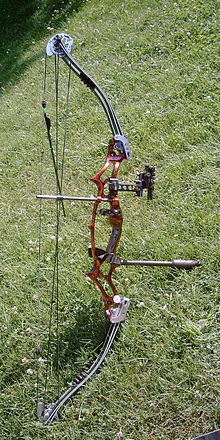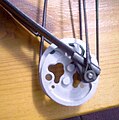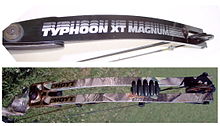Compound bow
The term compound bow ( Engl. Compound "composite") refers to a sheet with a special design principle and is not to be confused with composite bow , which refers to the material (composite).
description
The compound bow is a modern version of the bow invented by Holless Wilbur Allen in the USA in 1966 . Patent number 3,486,495 was granted on December 30, 1969. The most noticeable feature are small, cam-like eccentric "cam disks" or rollers ( camwheels ) at the ends of the bows , known as cams for short . They have two different diameters on which cables or tendons are rolled up. In the untensioned state, the tendon is rolled up on the larger of the two diameters. When the bow is tensioned, the bowstring is unrolled from the large diameter and the cable attached to the opposite limb is rolled up on the small diameter. The cams are also hung eccentrically.
The compound bow is often associated with the pulley block , but this was only used in earlier models that had more than two rollers. Because the pull cable is attached to the opposite end of the limb and runs over a roller, the whole system can also be understood as a fixed roller , which does not reduce the force.
Structure of a compound bow
Modern compound bows apply the law of leverage , just like a corrugated gear . The roller turning outwards is like a rigid lever that acts on the axis of rotation. The eccentric suspension of the rollers / cams changes the angle of attack and the lever arm, and you can always work in the most effective range. If the rollers / cams are pulled outwards with the bowstring, the lever arm is extended. These mechanisms are implemented in a practical application in the compound bow. In contrast to other bends, this results in a non-linear force curve when pulling out:
With increasing extension, the force initially increases steadily (as with other bows), but then suddenly decreases when the so-called summit pull weight is exceeded. When the bow is fully extended, the archer only holds a fraction of the weight of the summit pull in his hand. The draft reduction can be up to 99%, i. H. with a 50 pound summit pull, the shooter only needs to hold 0.5 pounds in the extension. This means that the bow can be held more steadily and aiming is much easier. Typical values here are around 70%, so that around 15 to 20 pounds must be kept in the extract.
The shape of the cams largely determines the behavior of the arch, in the simplest case they are circular. The shape of the cam can, for example, influence the reduction of the pulling weight or the energy “stored” in the tensioned bow. Some cams have interchangeable modules that can be used to adjust the draw length or draw weight of the bow.
In modern anatomically shaped compound bows, a distinction is made between right and left hand bows (example right hand bows: left hand holds the bow, right hand holds the arrow, the right eye is used for aiming).
- different cam embodiments
Due to its construction, a compound bow can be made considerably shorter with the same or even greater extension length and is either easier to pull or can be pulled with a much higher pulling weight with the same effort. The load on the moving parts is also lower, since the striking part of the string and the bow arms are much shorter and the cable pulls, in which the majority of the cocking or firing movement takes place, only have to move in the direction of their course. This significantly reduces vibrations when firing and the tendon wear. For these reasons the compound bow is well suited for hunting: it is more compact and can be kept in the 'ready to fire' position (fully extended) longer than other bow types.
On a compound bow, the arrows are initially weak and then accelerated more and more. As a result, the material of the arrows is less stressed and shooting speeds of more than 100 m / s or 360 km / h are achieved. Due to the high speed, the arrow is faster on the target (less distraction by wind) and the flight path is flatter. A flat flight path for the arrow is desirable as it reduces the effects of aiming errors at altitude. Such target errors arise, for example, from an incorrectly estimated distance to the target. For this reason, compound bows are very popular in so-called field archery, where the distance to the target must be estimated. The maximum range of compound bows is also greater than that of other types of bows.
Since the compound bow is under high tension, a bow press is often used for maintenance . In contrast to other types of bows, the compound bow is stored in a taut condition, so you don't have to pull the string open before use.
The compound bow is usually used with the following equipment:
- Visor at the front of the bow, usually with a magnifying glass (four to eight times magnifications are common);
- a small hole sight ("peep sight") worked into the string, through which you can see the front sight (like rear sight and front sight);
- Stabilizers, that is, bars that add weight;
- Arrow rest.
The tendon is often pulled with a mechanical trigger rather than with your fingers. These so-called “releases” are hooked onto the tendon or a cord attached to the tendon and triggered, for example, via a release lever. The use of a release also significantly reduces the rolling motion of the arrow, which benefits accuracy, as well as the risk of pulling the cables out of the guide groove of the cams (derailment), which would lead to dangerous, explosive destruction of the bow.
Camwheels
4wheeler
The compounds of the first hour were sheets with four rolls. Two pulleys, which were attached in front of or next to the eccentric rollers, had the main task of deflecting the pull cables from the center of the arrow path. At the limb ends were the other two round rollers that had an eccentric bearing. The effect was based on the pulley and eccentric principle. The train discount was around 33–36%.
Examples of different 4Wheelers: Bear Alaskan, Bear Tamerlan II, Bear Temuin II, Carrolls, Cupi,
Twin cam
These compound arches have two eccentrically rotating wheels that are more or less similar to ellipses . Each bow manufacturer has its own shapes or "cam disks". The functional principle here is based on the corrugated gear . The train discount reaches up to 80%.
Single cam
These bows only have a large eccentric wheel attached to the lower limb. The upper limb has only one pulley. The first drafts date back to 1975, but were long in the shadow of the Twin Cams. The advantage lies in the simple cam that does not have to be synchronized like the twin cams.
Hybrid cam
The hybrid cams have two different cams on the upper and lower limb. They are only connected by a split string, a control cable and the tendon and do not require anything like the effort of a twin cam in terms of fine-tuning. Hybrid cams have enjoyed increasing popularity since Hoyt introduced the "Cam & 1/2" system in 2003.
Binary cam
The binary cams are two mirror-image cams with three cable guides. The system was introduced by Bowtech Archery in 2005. The advantage lies in the arrangement of the string and cable. The tendon and both cables run from the upper to the lower cam, creating a free system. This will compensate for any possible imbalance in the limbs and the elongation of the tendon or cable. The Binary Cam is the system with the theoretically highest arrow speed and the easiest to tune.
Special forms
Some compound bows have the cams near the handle. The advantage is that the cams do not accelerate or decelerate any flywheels on the limbs. When attached to the middle section, no “vibrations” are transmitted to the arch.
Examples:
- Bear Delta V, was the fastest bow in 1981. The train discount was approx. 50-55%
- Oneida Eagle, with the somewhat unusual folding recurve / compound system
- Jennings Unistar with a double cam on one axis
- Bladerunner the latest version with two cams on the handle
Compound limbs
The compound limbs are made of glass fiber reinforced plastic (GRP). Glass fibers are both tensile and compressive and very efficient. The limbs are made of glass fibers that only run in one direction ( unidirectional arrangement) and are processed in a synthetic resin-bonded laminate . The successor is the more expensive carbon fiber reinforced plastic (CFRP).
"Forward Limb Movement"
The limbs move primarily forward, just like most limbs move.
"Vertical Limb Movement"
The limbs move mainly up and down. This comes from the almost parallel arrangement of the limbs in the horizontal plane. The advantage is a calmer arch that does not “jump” forwards, as the forces almost neutralize each other in the horizontal plane. The disadvantage is the short construction (axis distance), which only allows the bowstring to be tensioned with release . The tendon fingers would become too pinched.
"Twin Limb"
In contrast to the conventional one-piece limbs, twin limbs consist of "twin limbs" (two-piece, one above and one below). The cams can rotate between the twin limbs without having to cut out the limbs.
Arrow speed
The arrow speed is given in fps ( foot per second ).
According to the rules of the International Bowhunting Organization (IBO) and the rules of the Archery Manufacturer's Organization (AMO).
| Rule after | Arrow weight | Pull-out weight | Extension length | corresponding |
|---|---|---|---|---|
| IBO | 350 grain (22.68 g) | 70 lbs (31.75 kg) | 30 "(76.2 cm) | 5 grains per lbs |
| AMO | 365 grain (23.65 g) | 60 lbs (27.21 kg) | 30 "(76.2 cm) | 6 grains per lbs |
Individual evidence
- ↑ Patent US3486495 : ARCHERY BOW WITH DRAW FORCE MULTIPLYING ATTACHMENTS. Published December 30, 1969 , applicant: HOLLESS W ALLEN, inventor: ALLEN HOLLESS.
- ↑ Jennings Arrowstar with the "deflection rollers" ( Memento from October 8, 2007 in the Internet Archive )
- ↑ Jennings Twincams picture ( Memento from October 13, 2007 in the Internet Archive )
- ^ Prospectus from 1981 ( Memento from September 27, 2007 in the Internet Archive )
- ↑ Jennings Unistar ( Memento of October 13, 2007 in the Internet Archive )
- ↑ Homepage ( Memento of July 8, 2010 in the Internet Archive )
- ↑ Bladerunner ( Memento from May 11, 2008 in the Internet Archive )
- ↑ -Page ( Memento from September 15, 2008 in the Internet Archive )
- ↑ AMO vs. IBO Bow Speed ( Memento from February 20, 2015 in the Internet Archive )














